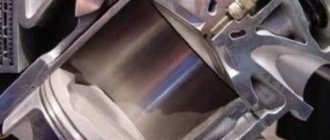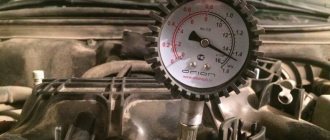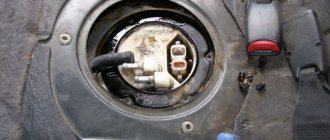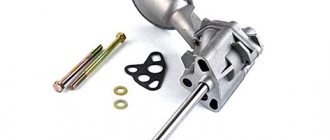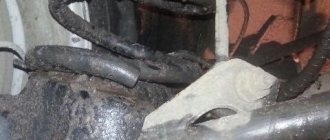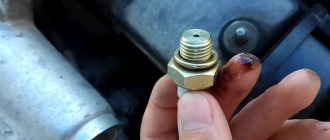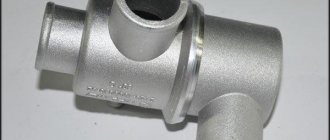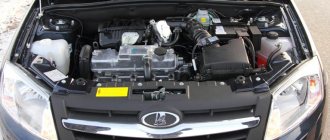This is a parameter that shows the maximum pressure in the cylinder when the engine is idling. More precisely, compression shows how efficiently the engine operates: its parameters must correspond to those declared by the manufacturer. Deviation from the standards specified by the factory leads to premature wear of the elements of the cylinder-piston group (CPG). That is why, after prolonged use of the car, it is recommended to regularly measure the compression in the engine. This can be done either in an equipped car service center or independently, provided you have special tools and equipment.
What is the difference between compression ratio and compression?
These two terms are often confused. Meanwhile, the first of them is not so difficult to understand. When the piston is at top dead center, there is a combustion chamber above it, which has a certain volume (V1). When the piston moves to the BDC zone, the volume of the piston is added to the volume of the combustion chamber (all together V2). To determine the compression ratio, you need to divide V2 by V1. This parameter (in fact, it is a coefficient) is determined by the manufacturer and is indicated in the car’s service book: for example, 9.5, 10 or 12, 14. That is, this number indicates that the working mixture will be compressed to 9.5, 10, etc. .d. times.
Another thing is compression (measured with a pressure gauge in atmospheres, kg/sq. cm, bars). This is the pressure created at the end of compression of the mixture when the piston enters the TDC zone. The higher the compression, the more powerful the power unit. It's simple: strong compression guarantees efficient combustion of fuel. But you cannot increase the compression indefinitely: the fuel will detonate (ignite spontaneously), which leads to the destruction of the power plant. As for specific values, in practice the compression is slightly greater than the compression ratio. For example, if the second parameter is 9.4, then the pressure in the cylinder may be 11-12 kg/sq.m. cm.
Signs of low compression and how to measure it on a VAZ engine
Compression on a VAZ 2114 should be measured every 30 thousand kilometers. This is usually done in conjunction with adjusting the valves. However, signs of low compression may not only appear during a routine check. During the operation of the car, signs of poor compression are detected quite simply, you just need to carefully monitor your engine. These are phenomena such as:
- The power of the internal combustion engine drops sharply;
- the engine troits, this can happen when low compression forms in one cylinder;
- Oil and gasoline consumption increases significantly.
Having discovered such signs, it is necessary to measure the compression in the engine. To carry out this procedure you need to prepare:
- before measuring compression in the engine, you need to fully charge the car battery and check the functionality of the starter, it must work without any problems;
- prepare a device for measuring compression, it is called a compression meter. It consists of a pressure gauge and a rubberized tube at the end of which there may be a threaded connection for screwing into the spark plug hole or a conical rubber tip that plugs this very hole like a plug;
- immediately before work, warm up the car, because the correct way to measure compression in the engine is to use a warm engine;
- Unscrew and remove all the spark plugs from the holes, placing them side by side in an accessible place. It is necessary to remove all the spark plugs, because if you unscrew only one and measure in this position, the compression level will not correspond to the true one;
- Turn off the fuel supply to the injectors by unscrewing the fuel hose.
When starting such work, you need to know what compression should be on the VAZ 2114. The normal pressure in the cylinders during compression should be 1.0 MPa; for an eight-valve engine in ideal condition it will be 1.4 MPa.
Having prepared properly to find out what the compression should be in the cylinders, install a compression gauge in the first cylinder.
Press the gas pedal all the way to fully open the throttle and thereby ensure maximum air flow. Then, turning the ignition key, use the starter to crank the crankshaft at speeds from 100 to 200 rpm for ten seconds. At this time, knowing what compression should be in the engine, it is necessary to monitor the readings of the pressure gauge of the measuring device installed in the spark plug hole:
- If the pressure initially increases slightly and then increases, then the piston rings are worn out. To verify this, just pour a little oil into this cylinder and measure again. The oil should plug the leak and compression should return to normal. This confirms that the rings need to be replaced;
- if the pressure increases to 0.8 MPa and then increases very slightly, then there are likely leaks in the valve or the cylinder head gasket is broken.
Carry out a similar procedure with measurements on all cylinders and record all readings. Upon completion of the work, install the spark plugs in place, connect the fuel hose and low-voltage wires. After cleaning the workplace, you need to analyze the records.
The pressure in the cylinders should not be lower than 1.0 mPa; this is the minimum compression indicator. The numbers for the cylinders should not differ much, no more than 0.2 MPa. If the compression reading in at least one cylinder is less than 1.0 mPa, a full check of the engine is required and, most likely, its repair.
You can do all this work yourself, or you can turn to specialists, you just need to find out in advance how much it costs to measure the compression in the engine.
Source
How is compression measured?
You can find out the maximum compression pressure in the cylinder using special devices - compression meters. They are divided into products intended for testing gasoline or diesel engines. There are also universal devices. In appearance, they are a pressure gauge with a tube made of elastic material or metal attached to it. If we take into account the principle of operation, there are two types of compression meters:
- Clamping. These are devices that are used to measure compression in gasoline internal combustion engines. A characteristic feature of such devices is a rubber bushing at the end of the tube. To take measurements, you will need an assistant to turn the ignition key.
- Threaded. These devices have a thread at the end of the tube, which allows the device to be screwed into the spark plug hole or injector installation location. The advantage of the product is that its use does not require the presence of a second person. The set of threaded devices also includes a rubber bushing: that is, they can be used in exactly the same way as the first version of the device.
- Flexible. These are compression gauges, where instead of a rigid metal tube, a flexible hose with a threaded tip and a rubber seal is connected to the pressure gauge. This design allows you to measure pressure in cylinders where access to the spark plug holes is difficult.
- Universal. With their help, compression is measured on diesel and gasoline engines. Such devices have a flexible hose with an extended tip. The latter can change: the device comes with adapters with different threads and diameters.
There are other devices that help determine the normal operation of the cylinders. Here it is worth mentioning the AGC - cylinder leakage analyzer. Its peculiarity is that it shows not pressure, but vacuum parameters. If it is full, you should look for leaks in the combustion chamber (check the valves, piston crown, wear on the cylinder walls). The condition of the rings can be judged by the residual vacuum. There is also a compressograph that records the received data on a medium (digital or paper). Car enthusiasts also use a motorcycle tester: the device determines pressure by changing the voltage and current strength that the starter consumes when it turns the crankshaft. Poor compression will be indicated by a decreasing current strength (in cylinders with normal pressure it will be higher).
Diagnostics without compressor
If you need to check the presence of compression after a long period of inactivity of the machine or a broken belt, and there is no compressor at hand, you can use alternative methods.
To check, remove the spark plug from the cylinder, take a plastic or rubber plug, and plug the spark plug well with it. If there is compression, the plug will fly out with a characteristic noise; if there is no compression, it will remain in place.
You can also remove spark plugs from all cylinders except the first. Then turn the crankshaft until the compression stroke is completed. This moment is determined by the marks of the gas distribution mechanism. The manipulation should be performed with each cylinder in turn. The presence of compression is checked by the degree of force applied. This method can hardly be called informative and accurate, so it is recommended to purchase a compression meter, which will be useful to any car owner.
Modern engines are quite complex devices, so their diagnostics require a special approach, the availability of special diagnostic equipment and operational experience. The more accurate the indicators obtained when measuring engine compression, the more likely it is to determine the cause of its decrease. If you need to carry out diagnostic work on the engine, specialists will help you. To do this, simply fill out the form below.
How is compression measured?
To obtain reliable results, when measuring compression, you must adhere to the following rules:
- warm up the engine to 70-90 degrees;
- shut off the fuel supply: disconnect the fuel pump power wire or disconnect the fuel hose (so that a lot of fuel does not get into the cylinders);
- remove all spark plugs to reduce rotational resistance;
- make sure that the starter is in working order and the battery is charged (it is recommended to use a starter charger - then the shaft will be guaranteed to rotate at the same speed when measuring compression in different cylinders).
Methods for measuring compression on a hot engine
There are a couple of main ways to measure pressure in internal combustion engine cylinders: with an open or closed throttle. Here we mean carrying out the procedure with the accelerator pedal depressed or in the absence of influence on it. Each of these methods allows you to obtain different results that help you more accurately determine the cause of the lack of compression.
Measurements with the damper open
In this situation, a lot of air is supplied to the cylinders, and the average pressure will be in the range of 11-13 kg/sq.m. cm (true for AI95 gasoline). In this case, measurements of air mass leakage are comparable to the amount entering the cylinder of an internal combustion engine. That is, if the pressure is below normal, this means that leaks occur by an “alternative method.” This may be a loose fit of the valve to the seat, a flaw in the camshaft cam profile (in engines with hydraulic lifters) or its wear, as well as a lack of tightness of the cylinder head gasket or a through crack in the combustion chamber.
How to check compression in an engine with the throttle closed
Here the picture is different. There is little air entering the cylinders, causing the cylinder pressure to increase, increasing leaks. But their volume will still be less than the amount of supplied air. Compression should be 12-14 kgf/sq.m. see. This method can determine the most severe defects:
- coking of rings (or their occurrence);
- burnout of a valve (one or more) or pistons (the latter may break);
- wear of the cylinder walls.
Measurements with oil added to cylinders
Both of the above methods do not allow taking into account the increase in pressure when the crankshaft rotates. For example, if it is low during the first steps - 4-5 kg/sq.m. cm, and then increases sharply, this may indicate wear or breakage of the piston rings. However, it makes sense to conduct additional testing. How to check compression taking into account the increase in pressure? To do this, pour a little (4-5 ml) of engine oil into the cylinder. This will increase compression, raise pressure on the first stroke and prevent gases from breaking through the rings into the crankcase. If the measured parameters have not changed, then it can be said with a high degree of probability that the cylinder head gasket is broken or the piston is burned out. When the pressure changes upward, we can talk about the occurrence, deformation or coking of the rings.
There is another side to using oil: if after adding it on subsequent strokes (after the first) the compression does not increase, it is worth checking the tightness of the valves (possibly a loose fit or burnout). When using both methods of measuring compression, first perform the procedure with the valve open, then with it closed.
Checking compression on a cold engine
This method is usually used in case of difficult starting. The pressure in the cylinders of a cold engine is sometimes 2 times (6-7 kg/sq. cm) less than normal when the parts of the cylinder-piston group are seriously worn out. After starting and subsequent warming up of the power unit, the compression rises by 3-5 units. If this is not the case, a major engine overhaul is needed. That is, it is obvious that a comprehensive check (both “cold” and “hot”) is more effective.
Checking compression with compressed air
This method allows you to more accurately understand the reason for the decrease in pressure in the problem cylinder. Adjust the piston to TDC on the compression stroke (all spark plugs must be removed and at the same time remove the plug from the oil filler neck). Next, you will need a compressor, with which you need to supply air under a pressure of 2 to 3 atmospheres into the “suspected” cylinder. If air comes out of the spark plug hole located nearby, it means the cylinder head gasket is damaged. A hissing sound from under the lowest carburetor gasket indicates a loose fit (or burnout) of the intake valve. Air flow from the neck indicates a violation of the integrity of the piston body or its burnout. And if hissing comes from the muffler pipe, it means the exhaust valve is faulty. The last trouble is the most common.
Below is a table of normal compression for the most popular cars:
Checking with a compression gauge
To measure the pressure in the engine cylinders, it is necessary to use a special tool - a compression gauge. The cost of such a device is low, so any car owner can purchase it. In addition to it, you will need a spark plug wrench and an assistant - he will have the important task of rotating the starter using the ignition key.
- The machine warms up to operating temperature.
- Carefully unscrew all spark plugs.
- The throttle valve opens, that is, the assistant presses the accelerator pedal all the way, while simultaneously turning the ignition key and thereby setting the starter in motion.
- The compression tester plug is tightly inserted into the spark plug well. The starter starts and the engine “cranks” for two to three seconds - this time is enough for the pressure gauge readings to stop increasing.
- The starter stops and the measurement data is recorded. Compression is measured in all engine cylinders.
- The compression gauge is completely emptied of air before each subsequent measurement. If the results obtained deviate from the norm, the readings are taken again.
Measuring engine compression using a compression meter video:
Compression values measured in different cylinders should be about 10% of the maximum pressure value indicated on the instrument scale. A decrease in results below 15% of the maximum indicates wear of parts - piston, valves, piston rings or cylinder. Operating a car engine in this condition risks its complete failure, major repairs, or complete replacement in the future.
The main difference between the process of measuring compression on an injector and a carburetor is the mandatory disconnection or removal of the crankshaft sensor. Experts advise doing this in order to protect the ECU from damage and completely shut off the fuel supply.
How to determine the pressure in diesel cylinders
To organize the procedure, you will need to prepare a well-charged battery and a compression gauge for working with diesel engines (it has special attachments and a measurement limit of up to 60-70 atmospheres). Engine compression is measured after it has warmed up. Following actions:
- remove the glow plug;
- screw the compression gauge into the vacated hole;
- turn off the diesel fuel supply (remove the power plug from the solenoid valve);
- ask a friend to press the accelerator (if the diesel engine has a valve that creates a vacuum used in the vacuum brake booster and regulator) and turn on the starter with the “start” button;
- remember (write down) the data obtained using the device;
- check the obtained values with those recommended by the car manufacturer (the necessary information is in the service book).
The compression value in a diesel engine depends on the brand of engine and is in the range of 28-40 kg/sq.m. see. An interesting dependence of compression in a diesel engine on the possibility of starting it at a certain outside temperature. Below are the compression values when the engine starts without problems:
- up to 28 kg/sq. cm: air temperature not lower than minus 15 degrees;
- up to 30 kg/sq. cm: normal start at minus 20;
- up to 32 kg/sq. cm: the engine will start at minus 25;
- up to 36 kg/sq. cm: start-up can be done at minus 30;
- up to 40 kg/sq. cm: diesel is able to start at 35 degrees below zero.
A drop in compression in diesel engines is accompanied by the appearance of a bluish exhaust from the muffler pipe, which is associated with incomplete combustion of fuel due to low temperature. Another consequence of a decrease in pressure in the cylinders is poor atomization of diesel fuel in the chambers, leading to a drop in power of the power unit.
Devices for measuring compression
To check the compression value in the cylinders we need a compression gauge. This is a device consisting of several parts. These include:
- special pressure gauge. It is better to take a part with a scale marked from 0 to 35 Bar. This parameter can be measured in atmospheres, kgf/cm2. or MPa, but the generally accepted unit of measurement is Bar, equal to 0.99 atmospheres;
- a flexible hose that screws directly into the pressure gauge. Equipped with a pressure relief valve. This will help measure compression on both gasoline and diesel internal combustion engines;
- one or more attachments that are screwed into the engine in place of the spark plugs;
When choosing a product on the market, it is advisable not to buy the cheapest meters. As a rule, their durability is short. But if you are not a car mechanic and do not plan to use the device often, purchasing a professional kit is also pointless. You should pay attention to models in the mid-price segment. The price of such devices is 750-1100 rubles.
| Device brand | Minimum cost, rub. |
| ZMZ-406 | 510 |
| Will measure | 625 |
| Avtodelo | 670 |
| Friend PRO | 750 |
| Friend | 1100 |
| FuelMerPro VAZ, GAZ TopAuto | 1290 |
| JTC | 3135 |
Why does compression drop over time?
It is impossible to avoid a decrease in pressure in the cylinders of the power unit: the wear process is constant. But it is quite possible to extend the service life of the engine if you know the reasons for the decrease in compression. And they can be the following:
- burnout of the piston or formation of cracks in its bridge;
- severe wear, misalignment or misalignment of the rings, leading to loss of their elasticity;
- cylinder surface wear;
- camshaft cam failure;
- deformation (even to the point of breakage) of valve springs;
- breakdown, burnout of the cylinder head gasket;
- the valve timing is incorrectly set (after repair): as a result, the valves do not close when needed - during the compression stroke they are slightly open.
Diagnosing faults
After taking measurements in all cylinders, you should pay attention to two points. The first is whether the measured compression corresponds to the minimum permissible value
The first is whether the measured compression corresponds to the minimum permissible value.
It is determined by the engine developers and is indicated in the repair manual.
The second is the difference in compression values in different cylinders of the same engine.
As a rule, it should not exceed 20% of the nominal value.
If you find that the pressure in any of the cylinders is below normal, inject three portions of oil into it from a manual oil can.
Do not inject more than three portions of oil, as excess oil can lead to the formation of a hydrostatic plug, which can cause breakage of the rings, piston, or even lead to a crack in the cylinder head.
The oil will seal the gap between the rings and the cylinder, and if the reason for the low compression was in this gap, then with such a “wet” test the compression should increase significantly.
Then check the condition of the rings, and if one of them is damaged or stuck, replace it.
If compression behaves this way in all cylinders, then it’s probably time for a serious repair with boring the cylinders and installing rings of the next repair size.
The effect of additives that increase compression is based on the effect of sealing gaps, similar to an oil wedge.
This is the easiest way to restore to some extent the former agility of the engine.
Only in this case you need to remember that their effect is quite short-lived, and repeated use no longer has such an effect.
Therefore, this method is often used before selling a car, so as not to spend money on expensive engine repairs.
If, after injecting oil into the cylinder, the compression changes slightly, then most likely the reason for its drop is a malfunction of the valve group or a broken cylinder head gasket.
From all that has been said, another conclusion follows: low, but approximately equal in all cylinders, compression indicates natural wear of engine parts, but a sharply different drop in one or more cylinders indicates a malfunction.
Sometimes damage or wear to the oil ring can cause compression to rise above the values set for a new engine.
This occurs because the worn ring does not remove excess oil from the cylinder walls, and it seals the gap between the cylinder and the compression rings, and then, during the power stroke of the piston, the oil burns out, forming carbon deposits on the cylinder head.
If this process continues for a long time, then the carbon layer becomes so significant that it leads to a decrease in the volume of the combustion chamber, and therefore to an increase in compression.
This phenomenon is dangerous due to engine detonation. It also leads to increased oil consumption.
Video: measuring compression correctly
Compression is an important indicator of engine health. If it is normal, then we can speak with confidence about the serviceability of its main parts: the cylinder head, cylinders, pistons, piston rings and valve group.
If the measured compression values differ from the values permissible by the engine manufacturer, then this is a reason to quickly determine and eliminate the cause of the malfunction.
Insufficient compression: what to do
Operating a vehicle with low pressure in the cylinders leads to damage to the CPG and timing parts. Moreover, the longer you do not take the necessary measures, the more expensive it will ultimately cost to repair the power unit. The most characteristic signs of compression loss:
- the engine became noticeably harder to start;
- engine operation is unstable in all modes;
- glutton of oil;
- fuel consumption has increased;
- the cylinders work poorly (the engine “troits”);
- an increase in pressure in the cooling system: antifreeze will begin to be squeezed out from under its gaskets;
- With a diesel engine, you can hear popping noises when the engine is running.
If the process of wear of timing elements and the cylinder-piston group has not reached a critical level, then you can use special additives that will somewhat delay the overhaul. You can also use a folk remedy, but only when the reason for the decrease in compression is the formation of a dense crust of deposits on the cylinder bore and piston heads. The procedure is as follows:
- Prepare denatured alcohol and kerosene.
- Mix 25 ml of each component in a suitable container (this is the volume of solution - 50 ml - for one cylinder).
- Start the power plant and warm it up, then turn it off.
- Turn out the candles and insert 50 g of the mixture into each hole.
- Leave the vehicle for 12 hours (overnight is possible).
- Inject 4-5 g of motor oil into the cylinders using a disposable syringe, screw in the spark plugs, start the internal combustion engine and let it run for half an hour. During this time, the deposits formed will burn out.
Instead of a mixture of kerosene and denatured alcohol, you can use special products for cleaning carbon deposits, sold in car dealerships. In this case, the algorithm of actions is slightly different:
- Unscrew the spark plugs and pour the purchased solution (30-40 g per cylinder) into the empty holes.
- Cover the holes with a rag to prevent dirt from getting in.
- Leave the car for 10-12 hours.
- Remove the rags and, without screwing in the spark plugs, crank the engine with the starter for 20-30 seconds.
- Clean the spark plugs and screw them in.
- Start the car, warm up the engine and drive out onto the highway. Accelerate the car to 110-130 km/h. At this speed it is recommended to drive 25-30 km.
Attention: do not try to screw in the spark plugs and start the car after filling the fluid in less than 10 hours: the remaining product can lead to water hammer and breakage of the CPG parts. After this, take compression measurements again. If it remains at the same level, then you will have to seriously restore the performance of the engine. This means replacing the rings, the pistons themselves and boring the cylinders (liners) to the nearest repair size.
Summarize
Compression is a diagnostic factor that allows you to objectively assess the health of the engine . Compression measurements will help identify the cause of engine malfunction, unstable operation, and increased oil or fuel consumption. Readings below normal do not mean that “the engine has gone to the bulkhead,” many different reasons affect compression. The main thing is to be able to distinguish between these causes, understand the degree of their danger and know methods to combat them.
Modern machines also require a modern approach, so it’s often impossible to do without a special tool. This applies both to those who like to work on their cars in the garage, and to professionals working at modern service stations.
A good, high-quality and accurate tool will save time, money and nerves. And working with him is a pleasure.
Measurement procedure
It all starts with preparation, as the basis for the competent conduct of any operation. In this case, it includes checking the condition of the engine, since the correctness of the measurement depends on this. For example, if even slight deviations are noticeable in the operation of the motor, they can affect the compression indicator during measurement.
Preparation also includes selecting the necessary tools:
- fully functional battery;
- pipe wrench;
- actually, the compression meter itself.
In some cases, especially for beginners, it is recommended to use the help of an assistant.
The measurement process itself looks like this:
- the motor initially heats up to a temperature of 50-60°;
- the spark plugs are unscrewed from the machine (using a pipe wrench or spark plug wrench);
- The crankshaft sensor is disconnected from the connector;
- the meter lead is screwed into the spark plug hole;
- the assistant turns on the ignition and presses the accelerator pedal;
- after the arrow on the meter stops, you need to write down the data;
- repeat the same procedure on all cylinders.
Why is the sensor disconnected? It's simple. This is done to prevent the controls on the computer from going wrong. In addition, in this way you can turn off the fuel supply to the injectors.
Compression can be measured on both a hot and cold engine.
| Hot engine | 1 cylinder | 2 cylinder | 3 cylinder | 4 cylinder |
| Open throttle and injectors disabled (ODZ) | 12.5 | 12 | 12 | 12 |
| Closed throttle and injectors disabled (ZDZ) | 11 | 10.05 | 10.05 | 11 |
| Open throttle connected injectors (fuel enters cylinders) | 12 | 11 | 11 | 11 |
| Cold engine | ||||
| Open throttle and injectors disabled | 12.3 | 11.5 | 11.5 | 11 |
| Closed throttle and injectors disabled | 12 | 11 | 11 | 12 |
| Open throttle connected injectors (fuel enters cylinders) | 13 | 12 | 12 | 12 |
Motor repair or replacement with a contract one?
In general, any malfunctions that lead to a decrease in compression in the engine cylinders can be eliminated. If the problem lies in the valves/cylinder head, then repair and restoration will cost 300-600 rubles. A liner for one cylinder will cost 80-120 rubles. If the pistons are damaged, they must be replaced. The price of the issue varies greatly depending on the engine and piston manufacturer. For example, for TFSI engines that suffer from oil burns, a Kolbenschmidt piston costs about 200 rubles, and the original costs 650 rubles apiece (these pistons come complete with all rings).
To these amounts should be added the costs of removing and installing the motor, disassembling and reassembling it. As a result, it turns out that the overhaul of the 2-liter TFSI/TSI engine, which is popular in terms of CPG problems, will cost about 3,600 rubles. This is if you change all four pistons. A contract engine costs from 2,500 to 3,000 rubles (plus replacement work, as well as consumables - 1,000 rubles). In this case – and we are talking about TFSI/TSI engines – many people go for a major overhaul, during which they install modernized pistons, with which the problem of “oil leakage” disappears.
Also, owners of cars whose engines chronically suffer from CPG wear: the appearance of scuffing on the cylinder walls also undergo major repairs with the block liner. This applies to many gasoline engines from BMW, Mercedes (and the Audi/VW engines mentioned above), as well as the widespread G4KD/4B11 engine (Kia, Hyundai, Mitsubishi), which is practically not offered in disassembly shops. Here it is advisable to solve the problem once and for all.
If the compression problem is associated with cylinder head wear, then you can also safely consider the option of restoring it. The work will cost, as we mentioned, 300-600 rubles, plus about 200-400 rubles for its removal and installation with replacement of the gasket.
In a large number of other cases, if a decrease in compression was caused by an accident, maintenance errors or huge mileage, you can safely consider the option of replacing the engine with a contract one. Motors that are not in great demand will cost 1000–2000 rubles, plus about 600–1000 rubles for removal and installation with oil change and necessary consumables.
Poor engine compression. What can it lead to?
Low engine compression levels are always a reason to be wary, because this can cause serious problems in the operation of the engine. One of the common manifestations of low air pressure in the engine is a reduced amount of oil in the engine. This is followed by difficulties when starting the engine, increased fuel consumption, and the engine may begin to stall. What is the reason for low compression? Now I'll try to tell you.
Engine overheating
The first reason is overheating of the power unit. If the temperature reaches a critical maximum, then irreversible processes occur inside the engine. If the cylinders overheat, the pistons and rings may burn out. It happens that the piston completely burns out, compression drops and the engine fails.
Problems in the gas distribution system
The gas distribution system is responsible for the intake and exhaust of engine exhaust gases. If the valve adjustment is incorrect, this may be one of the reasons for low compression. It is also worth paying attention to the timing marks, which may not be lined correctly.
Worn piston rings
When using a car, natural wear and tear occurs. Any part wears out, the only question is when it wears out. It’s more difficult with rings, because they are not visible. If they are too worn, this will affect engine compression. However, do not forget that correct operation of the car, according to the manufacturer’s recommendations, is the key to long-term operation of the engine.
Causes and consequences of high compression
If the compression measurement results are high, then it is worth checking to see if oil is getting into the combustion chamber or the engine is overheating.
The consequences of high compression lead to detonation and glow ignition, which in turn contributes to damage to the engine piston and cylinder.
At high compression rates, it is also worth checking whether the valve stem seals and rings are worn out or whether there is carbon deposits in the cylinders; the engine may need to decarbonize the internal combustion engine.
Checking compression when hot
First, let's answer the question - why is compression checked on a warm engine? The bottom line is that when diagnosing, it is important to know what maximum compression is possible in the engine at the peak of its power. After all, the lower this value is, the worse the condition of the engine. On a cold engine, compression is checked only if the car is difficult to start when cold, and all elements of the starting system have already been checked.
Before performing an engine compression test, you need to know what it should ideally be for the engine being measured. This information is usually found in the repair manual for the car or its engine itself. If such information is not available, then the compression can be calculated empirically.
How to find out approximately what compression should be
To do this, you need to take the value of the compression ratio in the cylinders and multiply it by a factor of 1.3. The value will be different for each engine, but for modern cars with a gasoline engine it is about 9.5...10 atmospheres for 76 and 80 gasoline, and up to 11...14 atmospheres for 92, 95 and 98. th gasoline. Diesel engines have 28...32 atmospheres for engines of older designs, and up to 45 atmospheres for modern engines.
The difference in compression between the cylinders can differ by 0.5...1 atmosphere for gasoline engines, and by 2.5...3 atmospheres for diesel engines.
How to measure compression when hot
When performing an initial hot engine compression check, the following conditions must be met:
Universal compression meter
- The engine must be warmed up; on a cold engine the value will be underestimated.
- The throttle should be fully open (gas pedal to the floor). If this condition is not met, the combustion chamber at top dead center will not be completely filled with the air-fuel mixture. Because of this, a slight vacuum will arise and compression of the mixture will begin at a lower pressure compared to atmospheric pressure. This will underestimate the compression value when checking.
- The battery must be fully charged. This is necessary so that the starter rotates the crankshaft at the required speed. If the rotation speed is low, then some of the gases from the chamber will have time to escape through leaks in the valves and rings. In this case, the compression will also be reduced.
After performing the initial check with the throttle open, you need to perform a similar check with the throttle closed. The conditions for its implementation are the same, but you don’t need to press the gas pedal.
